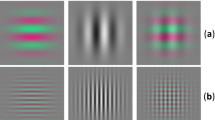Abstract
The Mach bands are directly related to the size and the shape of on-center off-surround neural units in human vision. The effects of various stimulus parameters were studied on both bright and dark bands of equal plateau intensities. At low overall intensities, the dark band increases markedly in width, while the bright band does not. However, the bandwidth is more affected by the brightness slope, than by the plateau intensity per se. In this case, both bands vary approximately linearly and inversely with the log of the slope. The bright bands are slightly wider (4′) than the dark bands, for matched intensities. Both bands almost double in width with only a ±30′ para-foveal fixation. Optical blur enlarges the bands as predicted from the spread function. A comparable enlarging effect found with pupil size increase is not so readily understood. The apparent centers of the bright bands are positioned significantly more asymmetrically between the two edges than are the dark band centers. Eccentric neural units are considered as possible explanations for some of these non-linearities.
Similar content being viewed by others
References
Baumgartner, G.: In: Neurophysiologie und Psychophysik des visuellen Systems, (ed.) R. Jung and H. Kornhuber, p. 296–311. Berlin-Göttingen-Heidelberg: Springer 1960.
Békésy, G. v.: Sensory inhibition. Princeton, N.J.: Princeton University Press 1967.
—: Mach and Hering type lateral inhibition in vision. Vision Res. 8, 1483–1499 (1968a).
—: Brightness distribution across the Mach bands measured with flicker photometry, and the linearity of sensory nervous interaction. J. opt. Soc. Amer. 58, 1–8 (1968b).
Bergstrom, S. S., Rubenson, B.: Contour effects on a brightness paradox. Vision Res. 10, 1057–1064 (1970).
Bliss, J. C., Macurdy, W. B.: Linear models for contrast phenomena. J. opt. Soc. Amer. 53, 1373–1379 (1961).
Bryndahl, O.: Perceived contrast variation with eccentricity of spatial sine-wave stimuli. Vision Res. 6, 553–567 (1966).
Burnham, R. W., Jackson, J. E.: Mach rings verified by numerical differentation. Science 122, 951–953 (1955).
Charman, W. N., Watrasiewicz, B. M.: Mach effect associated with microscope images. J. opt. Soc. Amer. 54, 791–795 (1964), esp. Pig. 5, p. 794.
Cornsweet, T. N.: Visual perception. New York: Academic Press 1970.
Davidson, M.: Perturbation approach to spatial brightness interaction in human vision. J. opt. Soc. Amer. 58, 1300–1308 (1968).
—, Whiteside, J. A.: Human brightness perception near sharp contours. J. opt. Soc. Amer. 61, 530–536 (1971).
Fiorentini, A.: Foveal and extra-foveal contrast threshold at a point of non-uniform field. Atti. Fond. Ronchi 12, 180–186 (1957).
—, Jeanne, H., Francia, G. T. di: Measurements of differential threshold in the presence of a spatial illumination gradient. Atti. Fond. Ronchi 10, 371–379 (1955).
—, Radici, T.: Binocular measurements of brightness on a field presenting a luminance gradient. Atti. Fond. G. Ronchi. 12, 453–461 (1957).
—: Brightness, width, positions of Mach bands as a function of the rate of variation of luminance gradient. Atti. Fond. G. Ronchi 13, 145–155 (1958).
Glezer, V. D.: The receptive fields of the retina. Vision Res. 5, 497–525 (1965).
Green, P. H.: Factors in visual acuity: I. Neural inhibition and the visual perception of contours. Bull. math, biophysics. 19, 147–156 (1957).
Guttinger, W.: Problems of information processing in the nervous system. Coral Gables Conference on Physical Principles of Neuronal and Organismic Behavior, Coral Gables, Florida, December 16–18, 1970.
Hartline, H. K., Ratliff, F.: Inhibitory interaction of receptor units in the eye of Limulus. J. gen. Physiol. 40, 357–376 (1957).
Jung, R., Spillman, L.: In: Early experience and visual information processing (ed.) F. A. Young and D. B. Lindsley, p. 181–197. Washington, D.C.: Nat. Acad. Sci. 1970.
Koffka, K.: Principles of gestalt psychology. London: Routledge & Kegan Paul 1935.
Lowry, E. M., DePalma, J. J.: Sine-wave response of the visual system: I. The Mach phenomenon. J. opt. Soc. Amer. 51, 740–746 (1961).
Ludvigh, E.: Perception of contour. I. Introduction. USNSAM Rep. No 4, Pensacola, Florida (1953 a).
Ludvigh, E.: Perception of contour. II. Effect of rate of change of retinal intensity gradient. USNSAM Rep. No 5, Pensacola, Florida (1953 b).
Mach, E.: Über die Wirkung der räumlichen Vertheilung des Lichtreizes auf die Netzhaut. S.-B. Akad. Wiss. Wien, mathnat. Kl. 52, 303–322 (1865).
Marimount, R. B.: Linearity and the Mach phenomena. J. opt. Soc. Amer. 53, 400–401 (1963).
McCullough, C.: The variation in width and position of Mach bands as a function of luminance. J. exp. Psychol. 49, 141–152 (1955).
O'Brien, V.: Contour perception, illusion and reality. J. opt. Soc. Amer. 48, 112–119 (1958), esp. Fig. 5A.
Ratliff, F.: Machbands, esp. p. 60–61. San Francisco: Holden-Day 1965.
Richards, W.: Illusory reversal of brightness contrast. Percept. Motor Skills 27, 1169–1170 (1968).
Sommerfeld, A. J. W.: Theoretical physics, optics (trans.) O. La Porte and P. A. Moldauer. New York: Academic Press 1954.
Spinelli, D. N.: Visual receptive fields in the cat's retina: complications. Science 152, 1768–1769 (1966).
Stevens, S. S.: Neural events and the psychophysical law. Science 170, 1043–1050 (1970).
Thomas, J. P.: Linearity of spatial integrations involving inhibitory interactions. Vision Res. 8, 49–59 (1967).
Tschermak, A. v.: Introduction to physiological optics (trans.) P. Boeder. Springfield, Ill.: Charles C. Thomas 1924.
Watrasiewicz, B. M.: Some factors affecting the appearance of Mach bands. J. opt. Soc. Amer. 56, 499–503 (1966).
Whiteside, J. A., Davidson, M. L.: Symmetrical appearance of bright and dark Mach bands from an exponential illumination gradient. J. opt. Soc. Amer. 61, 958–961 (1971).
Author information
Authors and Affiliations
Additional information
Supported, in part, by Research Grant No. EY00319-05 from the National Eye Institute, National Institutes of Health, Bethesda, Maryland, and by a fight for Sight Grant-in-Aid G-428 from the National Council to Combat Blindness, Inc., New York, New York.
Rights and permissions
About this article
Cite this article
Shipley, T., Wier, C. Asymmetries in the Machband phenomena. Kybernetik 10, 181–189 (1972). https://doi.org/10.1007/BF00288736
Received:
Issue Date:
DOI: https://doi.org/10.1007/BF00288736




